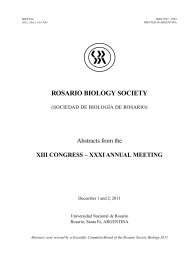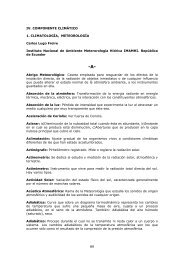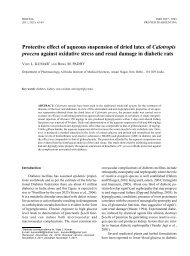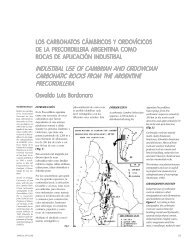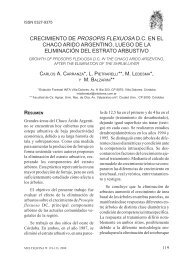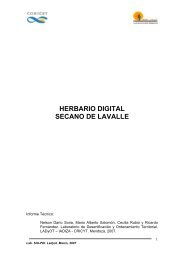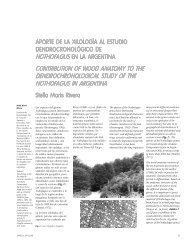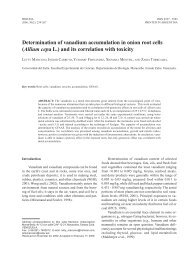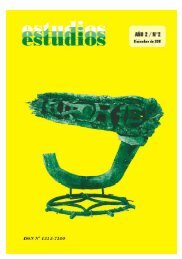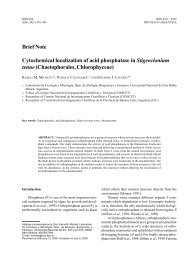XXII Annual Scientific Meeting, Tucuman Biology Society ...
XXII Annual Scientific Meeting, Tucuman Biology Society ...
XXII Annual Scientific Meeting, Tucuman Biology Society ...
Create successful ePaper yourself
Turn your PDF publications into a flip-book with our unique Google optimized e-Paper software.
206 ABSTRACTS<br />
161.<br />
REINTERPRETATION OF A MIDDLE EOCENE<br />
NOTOUNGULATE JAW FROM THE LUMBRERA<br />
FORMATION (SANTA BARBARA SUBGRUP, SALTA<br />
GROUP) FROM NW ARGENTINA<br />
Deraco MV, Powell JE.<br />
Facultad de Ciencias Naturales e I.M.L. Universidad Nacional de<br />
Tucumán. Miguel Lillo 205. (4000), S. M de Tucumán, Argentina.<br />
E-mail: virginia_deraco@yahoo.com.ar<br />
The aim of this contribution is to reanalize a complete jaw with all<br />
its teeth, previously assigned to the Family Notohippidae (Mammalia,<br />
Notoungulata), which is referred here as a Leontiniid. It was<br />
found in the upper third of the Lumbrera Formation (over the “Faja<br />
Verde II”) at El Simbolar, Guachipas Dept., Southern Salta Province.<br />
Its dental formula is 3i; 1c; 4pm; 3m. Incisives roots are compressed.<br />
The i3 is the biggest, a diagnostic feature of Leontiniids.<br />
Incisives and canine are procumbent. Premolars and molars are<br />
brachyo-dont. Premolars increase in size gradually from the pm2pm4.<br />
Molars lack posterior fosetid. The symphysis is short and<br />
reaches the mesial portion ot the p1. New discoveries in the same<br />
site and stratigraphic level have cleared up this misinterpretation.<br />
The size of the i3, the compression of the incisives and the extent<br />
of wearing of lophids of the molars, allow to consider this material<br />
as a new basal representative of the Family Leontinii-dae. It differs<br />
from other leontiniids of El Simbolar in its size and the morphology<br />
of the symphysis.<br />
162.<br />
DATES AND DENSITY OF SOWS AND SPACING AMONG<br />
LINE OF RICE IN UNIRRIGATED LAND<br />
Villegas JA, Perera JH, Agüero S.<br />
Facultad de Agronomía y Zootecnia, Universidad Nacional de<br />
Tucumán. Av. Roca 1900. 4000 San Miguel de Tucumán. E-mail:<br />
jav@faz.unt.edu.ar<br />
The present paper has the objective of to determine the influence<br />
of the date, density of sows and spacing among lines in aspects<br />
fenológicos and of yield of the rice cultivated without watering.<br />
The trial was carried out during the campaign 2.002-2.003, in the<br />
Experimental Field of the Facultad de Agronomía y Zootecnia,<br />
Universidad Nacional de Tucumán. <strong>Annual</strong> average: Rain: 1.188<br />
mm, EP(Thornthwaite): 1.000 mm, Excess: 270 mm in the period<br />
December – May., Deficiency: 7 mm in September and October. It<br />
has proven three date of sows (October, November and December),<br />
two densities (6 and 3 grams seed/m) and two distance among<br />
lines (0,5 and 0,3 meters). Results: the date of sows it influences in<br />
the final height of the plants, when sows in the 2 d date they reaches<br />
superior heights to the remaining ones, and that there are not yield<br />
differences among the densities of sows proven, although it observes<br />
significant interaction between dates and densities. Conclusion:<br />
the best combination corresponds to the sows in second date,<br />
with the biggest density and the smallest spacing among lines.<br />
BIOCELL 30(1), 2006<br />
163.<br />
STUDENTS EVALUATION OF THE DENTISTRY FACULTY<br />
OF THE NATIONAL UNIVERSITY OF TUCUMÁN<br />
Wuscovi LF 1 , Aragón HN, Colomo de Cutín CA 1 .<br />
1 Cát. Radiología, Fac Odontología, UNT. Av. B. Aráoz 800.<br />
Tucumán. E-mail: luis.wuscovi@odontologia.unt.edu.ar<br />
Educational institutions at world level, carry out controls of quality,<br />
through certain “factors”. They include information from different<br />
sources that are unified by countries with similar politics<br />
and economy (OECD). The aim of this study was to detect strengths<br />
and/or weaknesses of the educational quality of the Dental Faculty<br />
of the UNT, through the opinion of students. Systematized anonymous<br />
surveys applied to students (n=383) of first to fifth year, with<br />
15 items, 12 of them of multiple option, and 3 to complete. The<br />
analyzed aspects were: 1) types and evaluation frequency 2)<br />
pedagogic strategies, teaching-learning technique that students took<br />
advantage of 3) time dedicated to student’s attention 4) weekly time<br />
dedicated to study 5) suggestions to improve practice 6) affective<br />
relationship 7) students consults attention. Results included: 1)<br />
Written applied evaluations were low 2) the strategy students took<br />
advantage of was theory and practice (64%) 3) 62% considered<br />
enough time dedicated to students, 4) 31% of the students dedicate<br />
less than 1 h to study 5) students request more time of practice, 6)<br />
student-teachers relationship was very good and good 7) 53% said<br />
teachers “always” attend consults and 37% said “sometimes”. Conclusions:<br />
much problems of pedagogic nature could be detected as<br />
those related with students well-being. This should be applied on<br />
University politics to improve institutional quality.<br />
164.<br />
DETECTION OF THE HIV VIRUS IN TOTAL SALIVA OF<br />
HIV/AIDS PATIENTS<br />
Salúm MK 1 , Tonello U 2 , López ME 1 , Diaz Ricci JC 2 .<br />
1 Cát. Quím. Biol., Fac. Odontol. 2 Inst. Quím. Biol., Fac. Bioq, Quím.<br />
y Farm., UNT. Av. B. Aráoz 800. (4000) S. M. Tucumán. E-mail:<br />
karina.salum@odontologia.unt.edu.ar<br />
Certain evidences suggest that orofaringeous tissues can reserve<br />
the HIV and sustain viral replication. Total saliva (TS) is a complex<br />
mixture of gland secretions, where recent studies detected the<br />
virus by ELISA and Western Blot in HIV patients with gingivoperiodontal<br />
affection. The aim of this work was to associate viral<br />
RNA presence in TS of individuals HIV/AIDS, using the PCR technique,<br />
with the immunologic state. 15 HIV+ patients, both sexes,<br />
33-45 yrs old were selected. Non stimulated TS was collected in<br />
10 min of the sublingual and vestibule regions, centrifuged at 12000<br />
rpm 60 min at 4ºC and conserved at –70ºC. Patients were divided<br />
according to their CD4 values: 500 cel/μl, 500-200 cel/μl and



